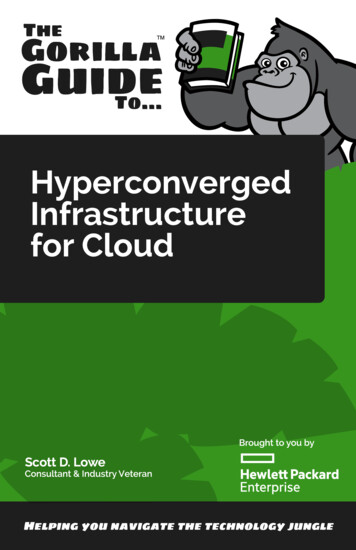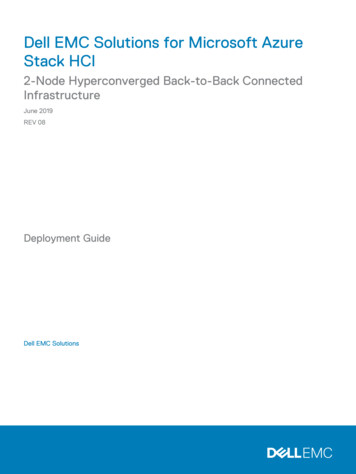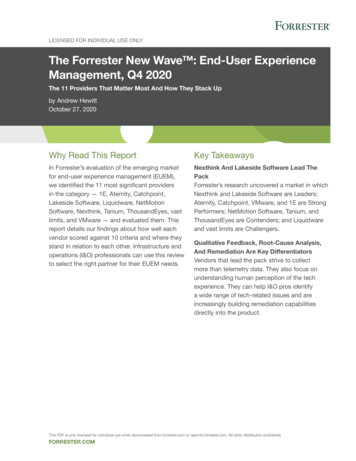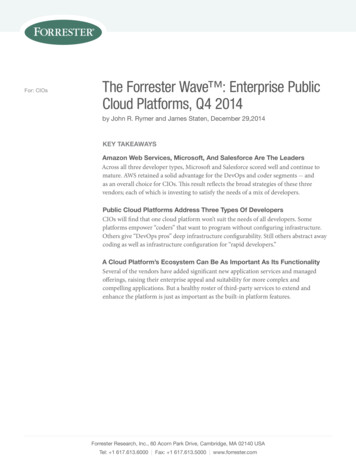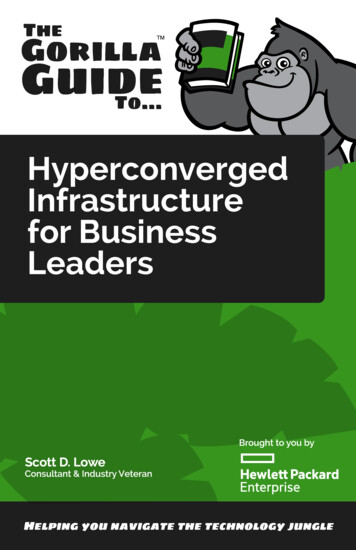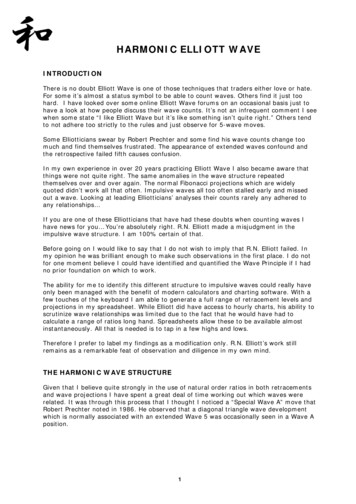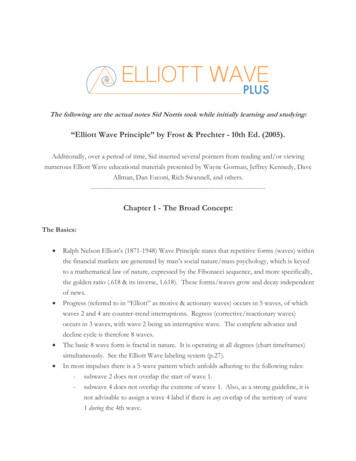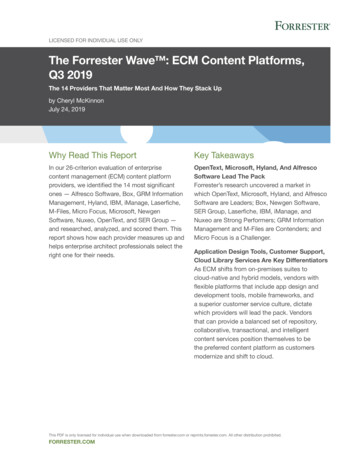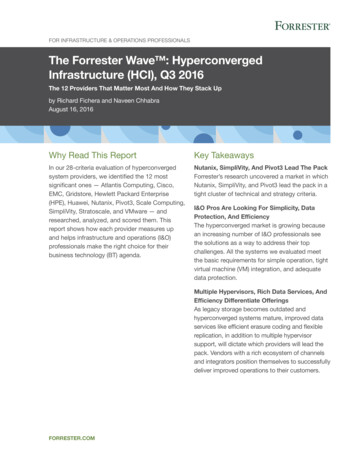
Transcription
For Infrastructure & Operations ProfessionalsThe Forrester Wave : HyperconvergedInfrastructure (HCI), Q3 2016The 12 Providers That Matter Most And How They Stack Upby Richard Fichera and Naveen ChhabraAugust 16, 2016Why Read This ReportKey TakeawaysIn our 28-criteria evaluation of hyperconvergedsystem providers, we identified the 12 mostsignificant ones — Atlantis Computing, Cisco,EMC, Gridstore, Hewlett Packard Enterprise(HPE), Huawei, Nutanix, Pivot3, Scale Computing,SimpliVity, Stratoscale, and VMware — andresearched, analyzed, and scored them. Thisreport shows how each provider measures upand helps infrastructure and operations (I&O)professionals make the right choice for theirbusiness technology (BT) agenda.Nutanix, SimpliVity, And Pivot3 Lead The PackForrester’s research uncovered a market in whichNutanix, SimpliVity, and Pivot3 lead the pack in atight cluster of technical and strategy criteria.I&O Pros Are Looking For Simplicity, DataProtection, And EfficiencyThe hyperconverged market is growing becausean increasing number of I&O professionals seethe solutions as a way to address their topchallenges. All the systems we evaluated meetthe basic requirements for simple operation, tightvirtual machine (VM) integration, and adequatedata protection.Multiple Hypervisors, Rich Data Services, AndEfficiency Differentiate OfferingsAs legacy storage becomes outdated andhyperconverged systems mature, improved dataservices like efficient erasure coding and flexiblereplication, in addition to multiple hypervisorsupport, will dictate which providers will lead thepack. Vendors with a rich ecosystem of channelsand integrators position themselves to successfullydeliver improved operations to their customers.forrester.com
For Infrastructure & Operations ProfessionalsThe Forrester Wave : Hyperconverged Infrastructure (HCI), Q3 2016The 12 Providers That Matter Most And How They Stack Upby Richard Fichera and Naveen Chhabrawith Glenn O’Donnell, Andrew Hewitt, and Diane LynchAugust 16, 2016Table Of Contents2 Hyperconvergence Is A Concept WhoseTime Has ComeNotes & ResourcesTechnology Must Obscure Complexity ToHelp Protect People From ThemselvesForrester conducted product evaluations inMay 2016 and interviewed 12 hyperconvergedsystems vendors and their references: AtlantisComputing, Cisco, EMC, Gridstore, HewlettPackard Enterprise (HPE), Huawei, Nutanix,Pivot3, Scale Computing, SimpliVity, Stratoscale,and VMware.Hyperconvergence Delivers On The PromiseOf Infrastructure-As-A-Service (IaaS)Related Research DocumentsLegacy Hypervisor-Based Infrastructure DidLittle To Hide The Complexity4 Hyperconverged Systems Have A BroadRange Of Use CasesBrief: Four Trends Transforming EnterpriseStorage To Support The BT Agenda5 Hyperconverged Systems EvaluationOverviewSimplify And Accelerate Your Infrastructure WithHyperconvergenceEvaluated Vendors And Inclusion CriteriaVendor Landscape: Hyperconverged Platforms7 Vendor ProfilesLeadersStrong PerformersContenders13 Supplemental MaterialForrester Research, Inc., 60 Acorn Park Drive, Cambridge, MA 02140 USA 1 617-613-6000 Fax: 1 617-613-5000 forrester.com 2016 Forrester Research, Inc. Opinions reflect judgment at the time and are subject to change. Forrester ,Technographics , Forrester Wave, RoleView, TechRadar, and Total Economic Impact are trademarks of ForresterResearch, Inc. All other trademarks are the property of their respective companies. Unauthorized copying ordistributing is a violation of copyright law. Citations@forrester.com or 1 866-367-7378
For Infrastructure & Operations ProfessionalsAugust 16, 2016The Forrester Wave : Hyperconverged Infrastructure (HCI), Q3 2016The 12 Providers That Matter Most And How They Stack UpHyperconvergence Is A Concept Whose Time Has ComeA flexible cloud computing model has proven central to nimble adaptation for quickly changingcustomer expectations. As I&O pros around the globe increasingly virtualize their infrastructure,operating ever-larger cloud-like infrastructures has gained a higher profile. More virtualization hasresulted in more complexity at a time when complexity is already excessive. In response to thisgrowing problem, the first hyperconverged system emerged in 2011.1 Hyperconverged platformsdisrupt the traditional hardware infrastructure vendor landscape because they let customers buildscalable virtualized infrastructure without requiring silo-focused expertise in areas such as storage andstorage area network (SAN) management. Forrester defines hyperconvergence as:An approach to technology infrastructure that packages server, storage, and network functionsinto a modular unit and adds a software layer to discover, pool, and reconfigure assets acrossmultiple units quickly and easily without the need for deep technology skills. These systems canbe implemented either as software plus modular physical units or as a software overlay on top ofexisting infrastructure.Legacy Hypervisor-Based Infrastructure Did Little To Hide The ComplexityLegacy hypervisor-based infrastructure exposed too many underlying system details, unnecessarilyadding to operational complexity. The routine task of adding capacity — particularly storage andcompute capacity — became increasingly onerous, distracting I&O professionals from tasks thatdeliver more value to their companies’ BT agendas. Tech management professionals are demandingtighter management integration across virtualization and storage silos to boost the efficiency of theirinfrastructures to match customer demands.Technology Must Obscure Complexity To Help Protect People From ThemselvesComplexity is inevitable, but it’s usually a self-inflicted issue. Infrastructure is typically designedwith the best tools and design methodologies available at the time but often with unclear or missinginformation about future requirements. As these environments scale and change, the limitations ofthe underlying technology become more and more apparent, manifesting themselves as increasingcomplexity and instability. Complexity and instability have a tendency to become nonlinear as thenumber of nonisolated potential interactions between components increases. At the same time, asmall minority of people who have profound technology expertise rooted in the current environmentand are resistant to change sometimes complicate these legitimate aspects of complexity. The resultis like a Frankenstein’s monster that turns on its creators. Even those with the deepest technicalexpertise will find themselves crushed under the weight of its complexity, and the business will suffercommensurately. Technology must protect us from ourselves. 2016 Forrester Research, Inc. Unauthorized copying or distributing is a violation of copyright law.Citations@forrester.com or 1 866-367-73782
For Infrastructure & Operations ProfessionalsAugust 16, 2016The Forrester Wave : Hyperconverged Infrastructure (HCI), Q3 2016The 12 Providers That Matter Most And How They Stack UpHyperconvergence Delivers On The Promise Of Infrastructure-As-A-Service (IaaS)The next wave of integrated systems, beyond the base level of converged hardware integration, ishyperconvergence, which installs a software-defined storage layer optimized for VM-aware operationon top of an integrated hardware and system software stack.2 The earlier generation of convergedinfrastructure (CI) combined resources into single physical units, which was a great first step to trulyunifying infrastructure. Hyperconvergence adds more flexibility by treating the entire pool of physicalunits as a unified virtual entity. With minimal administrative burden, you can morph this pool into moreflexible configurations and treat the storage as native objects in the virtualization abstraction layer. Afluid resource pool is central to the whole notion of cloud computing. If you wish to develop cloud-likeservices atop your infrastructure, hyperconverged systems represent a very promising platform. Whenyou’re forced to manipulate individual components, the process is complex and fragile, even whencloud software automates it. Let the infrastructure itself produce the needed capabilities.Forrester believes that a hyperconverged system must have all of the following:›› Integrated compute and storage resources. At the core of the hyperconverged value propositionis the simplicity of scaling the cluster, which in part derives from the co-provisioning of compute andstorage resources in preintegrated modules. In contrast, basic CI solutions bundle and preintegratediscrete server and storage units. One glaring and immediate concern of potential users was thatthis presupposes that the ratio of compute and storage is fixed and that the vendor has guessedcorrectly.3 Hyperconverged systems vendors have dealt with this in three ways: 1) They made wellinformed assumptions with their initial set of offerings; 2) many of them offer modules with differinglevels of compute and storage; and 3) some can access and federate external storage resources.4›› Software-defined storage. The core value of a hyperconverged system is the simplicity it brings tothe management of VM storage. Hyperconverged systems must also provide a software abstractionof the federated storage of the physical nodes and present this storage to the hypervisor. Forexample, the Nutanix Distributed File System (NDFS) fulfills the storage aggregation and resiliencyfunctionality. Storage functionality beyond this baseline requirement varies considerably, and suchvariations represent a major part of the current differentiation among vendors.›› Automatic discovery and configuration. The third leg of the hyperconverged concept is thatthe hyperconverged system must be capable of discovering and adding a new resource to theenvironment with minimal operator interaction. While this is hard to quantify in terms of the numberof required operator interactions or time investment, Forrester believes that a hyperconvergedsystem should be able to add a new module with an additional 20 terabytes (TB) to 100 TB ofstorage in no more than 15 minutes of operator time and that none of the incumbent members ofthe cluster should require any administrative intervention.›› Minimal management outside the hypervisor console. Management must be largely within thepurview of the hypervisor console, enhanced further with APIs for integrating with other automationtools such as cloud management suites.5 Other than initial setup, avoid manually managing such 2016 Forrester Research, Inc. Unauthorized copying or distributing is a violation of copyright law.Citations@forrester.com or 1 866-367-73783
For Infrastructure & Operations ProfessionalsAugust 16, 2016The Forrester Wave : Hyperconverged Infrastructure (HCI), Q3 2016The 12 Providers That Matter Most And How They Stack Updynamic systems from the command line, as this method is costly and prone to errors. Localsystem management must be minimal, with extensive automation of required management tasks.Again, this is an area in which vendors will innovate and differentiate, but the basic requirement isto reduce the number of operator interventions.Hyperconverged Systems Have A Broad Range Of Use CasesIn short, any use case that demands rapid resource allocation will benefit from hyperconvergence.Thus, we expect hyperconverged systems to become ubiquitous, fueling a rush to market by alltechnology vendors. Vet solutions carefully, as many will stretch the definition to gain traction.Interviews with Forrester clients and systems vendors provided us with the following set of use caseswhere I&O pros can advantageously deploy hyperconverged systems:›› Virtual desktop infrastructure (VDI). Hyperconverged systems can offer a very efficientdeployment platform. Embedded deduplication is a strong positive for the VDI use case,and performance, system overhead, and efficiency of vendor deduplication algorithms vary.Deduplication is advantageous in many use cases but critical in VDI because of the high degree ofreplication of identical data in multiple desktop images. A VDI system with efficient deduplicationmay enjoy a 10-to-1 or greater advantage in storage efficiency over a nondeduplicatedenvironment. For VDI, deduplication processing is generally not performance-intensive because themajority of the processing occurs only at the time of image generation and the reconstruction ofthe invoked image is less resource-intensive.6›› IaaS environments with large numbers of stored VM templates. This use case is similar to theVDI use case. The savings also come in the form of deduplicated storage for the large number oftemplate files that you’ll use to build future images, as well as the stored images themselves.›› High-volume VM snapshotting. VM snapshots are an important element of a global disasterrecovery/business continuity (DR/BC) strategy, but generating these snapshots tends to causestorage requirements to balloon, and the replication of them to a remote location can strainnetwork resources.7 A hyperconverged system with embedded deduplication, whether immediateor deferred, can yield significant benefits in storage utilization and network load and can improveDR/BC options. Feedback from enterprise clients indicates that the existence of this capability willmotivate clients and stakeholders to generate snapshots more often, so I&O professionals must beprepared. Nonetheless, illustrations of operational results showing a greater than tenfold savings inspace convince us that the results will be positive for most customers.8›› General VM clusters. Independent of deduplication, hyperconverged systems provide anextremely cost-efficient way to deploy capacity for general-purpose IaaS environments.Contributing factors include reduced management overhead, rapid provisioning, and efficientmanagement of a global federated storage resource at a low cost. This cost is at least competitiveon a capital cost basis with a standard rack solution and homegrown integration. Even workloads 2016 Forrester Research, Inc. Unauthorized copying or distributing is a violation of copyright law.Citations@forrester.com or 1 866-367-73784
For Infrastructure & Operations ProfessionalsAugust 16, 2016The Forrester Wave : Hyperconverged Infrastructure (HCI), Q3 2016The 12 Providers That Matter Most And How They Stack Upwhere VMs have historically strained a bit, such as online transaction processing (OLTP), arereadily addressable, as vendors have increased the number of node configurations available,including all-flash nodes offered by multiple vendors. Scalability of hyperconverged systems hasescalated rapidly, as has the deployment of general-purpose enterprise workloads such as majorindependent software vendor (ISV) solutions and databases.9›› Analytics clusters. Early deployments of Hadoop and other analytics tools on hyperconvergedsystems indicate that ease of scalability and simplified storage management benefits far outweighthe drawback of losing control over physical resource placement across the systems, and Forresterexpects to see a ramp in hyperconverged systems as an alternative to generic Hadoop clusters.Analytics is another workload where the availability of all-flash nodes will be a major plus.10Hyperconverged Systems Evaluation OverviewTo assess the state of the hyperconverged systems market and see how the vendors stack up againsteach other, Forrester evaluated the strengths and weaknesses of top hyperconverged systemsvendors. After examining past research, user need assessments, and vendor and expert interviews, wedeveloped a comprehensive set of evaluation criteria. We evaluated vendors against 28 criteria, whichwe grouped into three high-level categories:›› Current offering. We evaluated the capabilities of the current offerings according to our set of criteria.›› Strategy. We assessed each vendor’s strategic positioning as a factor of several evaluation criteria.›› Market presence. This category indicates the relative ranking of the vendors in terms of theircustomer installations and revenues. In cases where the vendor did not disclose, Forrester hasmade estimates.Evaluated Vendors And Inclusion CriteriaForrester included 12 vendors in the assessment: Atlantis Computing, Cisco, EMC, Gridstore, HewlettPackard Enterprise, Huawei, Nutanix, Pivot3, Scale Computing, SimpliVity, Stratoscale, and VMware.Each of these vendors has (see Figure 1):›› A hyperconverged product in general availability. Forrester required that the evaluated productand version be available for general purchase, not in beta or restricted availability. The same policyapplies for features and point upgrades — we have included only currently shipping features.This stricture had significant effects on products that, while they have impressive technology roadmaps and might score much better in the future, don’t have the required features in productiontoday. Many of the evaluated products are capable of running on multiple hardware platforms, andForrester has evaluated only the software capabilities, or in the case of bundled appliances, theprimary hardware/software combination. The existence of differences across multiple platformswas an evaluation criterion. 2016 Forrester Research, Inc. Unauthorized copying or distributing is a violation of copyright law.Citations@forrester.com or 1 866-367-73785
For Infrastructure & Operations ProfessionalsAugust 16, 2016The Forrester Wave : Hyperconverged Infrastructure (HCI), Q3 2016The 12 Providers That Matter Most And How They Stack Up›› Referenceable customers. Forrester requires that vendors supply at least three referencecustomers. Forrester directly collected these evaluations.›› The ability to demonstrate the product. An integral part of the Forrester Wave evaluation processis a product demonstration, which we record for reference. We supply a script specifying a set oftasks to the vendors, and at a minimum, they must perform all the tasks in the script. The script forthe hyperconverged vendors specified a series of critical operational tasks, including initial setup,creating a VM, setting up replication and data protection policies (if supported), adding capacity,and shutting down a node to prove the resiliency of the system. We encouraged vendors to showadditional features beyond the required script.›› An offering that has drawn significant interest from Forrester clients. Forrester clientsfrequently mention the included vendors in inquiries and other forms of client interaction. 2016 Forrester Research, Inc. Unauthorized copying or distributing is a violation of copyright law.Citations@forrester.com or 1 866-367-73786
For Infrastructure & Operations ProfessionalsAugust 16, 2016The Forrester Wave : Hyperconverged Infrastructure (HCI), Q3 2016The 12 Providers That Matter Most And How They Stack UpFIGURE 1 Evaluated Vendors: Vendor Information And Selection CriteriaVendorProductAtlantis ComputingHyperScale HS-336CiscoHyperFlex HX SeriesEMCVxRailGridstoreHyperconverged Infrastructure v3.5HPEHyper Converged 380 (HC380)HuaweiFusionCubeNutanixAcropolis v4.6Pivot3vSTAC v7.3Scale ComputingHC3SimpliVityOmniStack 3.5.1StratoscaleSymphonyVMwareVirtual SAN 6.2Vendor selection criteriaForrester defines hyperconverged infrastructure as an approach to technology infrastructure thatpackages server, storage, and network functions into a modular unit and adds a software layer todiscover, pool, and reconfigure assets across multiple units quickly and easily without the need for deeptechnology skills. These systems can be implemented either as software plus modular physical units or asa software overlay on top of existing infrastructure. For this product evaluation, all participants must have:1. A hyperconverged software offering available for purchase by May 1, 2016. Pricing must be public.2. At least three production references they can share with Forrester for evaluation.3. The ability to demonstrate key aspects of the product’s functionality.4. An offering that has drawn significant interest from Forrester clients.Vendor ProfilesWe intend this evaluation of the hyperconverged market to be a starting point only. We encourageclients to view detailed product evaluations and adapt criteria weightings to fit their individual needsthrough the Forrester Wave Excel-based vendor comparison tool (see Figure 2). 2016 Forrester Research, Inc. Unauthorized copying or distributing is a violation of copyright law.Citations@forrester.com or 1 866-367-73787
For Infrastructure & Operations ProfessionalsAugust 16, 2016The Forrester Wave : Hyperconverged Infrastructure (HCI), Q3 2016The 12 Providers That Matter Most And How They Stack UpFIGURE 2 Forrester Wave : Hyperconverged Infrastructure (HCI), Q3 ’16Challengers ntis caleHuaweiCurrentofferingGo to Forrester.com todownload the ForresterWave tool for moredetailed productevaluations, featurecomparisons, andcustomizable rankings.HPECiscoScale ComputingMarket presenceWeakWeakStrategyStrong 2016 Forrester Research, Inc. Unauthorized copying or distributing is a violation of copyright law.Citations@forrester.com or 1 866-367-73788
For Infrastructure & Operations ProfessionalsAugust 16, 2016The Forrester Wave : Hyperconverged Infrastructure (HCI), Q3 2016The 12 Providers That Matter Most And How They Stack UpSTRATEGYCustomer feedbackMARKET PRESENCEInstalled baseImplementation engineersDedicated engineersTechnology partnersAtlantis ComputingCiscoEMCGridstoreHewlett Packard EnterpriseHuaweiNutanixPivot3Scale ComputingSimpliVityStratoscaleVMwareCURRENT OFFERINGHypervisor supportNonvirtualized environment supportHardware platform supportMaximum configurationHyperconverged functionsHigh availability and data protectionManageability and ease ofoperationsForrester’sWeightingFIGURE 2 Forrester Wave : Hyperconverged Infrastructure (HCI), Q3 ’16 .254.154.505.0050%100%0%50%10%10%30%3.00 3.68 2.98 3.00 3.00 2.32 4.34 3.68 3.66 4.34 3.00 2.323.00 3.68 2.98 3.00 3.00 2.32 4.34 3.68 3.66 4.34 3.00 2.501.502.001.001.001.004.805.004.004.005.00All scores are based on a scale of 0 (weak) to 5 (strong).Leaders›› Nutanix. Nutanix is currently the largest supplier of integrated HCI appliances and widely creditedwith coining the term “hyperconverged” at the time of its 2011 HCI introduction. Nutanix not onlyis the largest appliance vendor but also has the most customers in our evaluation (3,100-plus), has1,800 employees, and operates in 80 countries. Nutanix also boasts some of the largest managedclusters, with more than 100 nodes in its largest customer clusters. Nutanix stands out in its easeof use, simplified management, and no-disruptive capacity. Its annual revenue run rate, estimatedby Forrester at approximately 200 million, places it as the highest revenue contributor to the HCIecosystem (VMware VSAN, while shipping more node licenses, probably does not generate asmuch revenue). 2016 Forrester Research, Inc. Unauthorized copying or distributing is a violation of copyright law.Citations@forrester.com or 1 866-367-73789
For Infrastructure & Operations ProfessionalsAugust 16, 2016The Forrester Wave : Hyperconverged Infrastructure (HCI), Q3 2016The 12 Providers That Matter Most And How They Stack Up›› SimpliVity. SimpliVity is targeting enterprise storage services and multisite environments throughits OmniStack hyperconverged infrastructure offering. The OmniStack product, available as anintegrated appliance based on a Cisco, Dell, or Lenovo server, offers a very rich set of globalmultisite data management functions anchored by an always-on global deduplication architecture.It includes a comprehensive set of backup, deduplication, snapshot, and clones with multisitedata replication and DR capabilities along with wide-area network (WAN) optimization. OmniStackclusters have more-modest scale limits than many other offerings, at a maximum of 24 nodes in alocal cluster, but it compensates with its strong multisite capability. Cluster size has not affecteddeployment of OmniStack at large enterprise accounts. Maximum total raw storage in a set oflinked clusters is in the order of 1.3 petabytes (PB).›› Pivot3. Pivot3 has been quietly shipping hyperconverged systems since 2007, before better-knownvendors such as Nutanix and SimpliVity, and has accumulated more than 2,000 customers. Itshistorical customer base is in surveillance and media storage, leveraging the strength of its efficientand very scalable data protection technology (Pivot3 boasts one of the two largest hyperconvergeddata storage clusters we found in our research). Because it has not focused on general enterpriseenvironments, it’s been flying under the radar for some time. In the past 18 months, the companyhas made a concerted effort to sell outside of its historical strongholds, and in its most recentquarter, it reported that, for the first time, nonsurveillance applications accounted for the majority ofits sales. Despite its smaller size and visibility, Pivot3 is a strong candidate, especially if requirementsinclude PB-scale data storage, where its space-efficient data protection may reduce costs.Strong Performers›› Atlantis Computing. Atlantis Computing has been selling storage software solutions since mid2015, entering the HCI market with a solution based on aggressively priced midsize (up to 24 TB)flash-based server nodes. Atlantis was one of the first vendors to answer concerns about datareduction efficiency by selling nodes based on their net effective capacity, with an underlyingguarantee to add media if the system failed to deliver on its effective capacity. Atlantis sells throughchannels and currently supports hardware from Dell, HP, Lenovo, and Supermicro. Atlantis is arelative newcomer and has a small market footprint, but its overall capabilities give it a strongposition in this Forrester Wave.›› Gridstore. Gridstore is unique in its Microsoft specialization, currently supporting only Hyper-Vand integration with Microsoft’s environment. The most recent version of Gridstore, V3.5, adds tothis already tight integration with Microsoft Windows Server and System Center with support forAzure Pack. Gridstore’s flash-based architecture allows independent scaling of its compute andstorage resources and scales to multi-PB sizes and up to 64 compute and 256 storage nodes.One unique aspect of Gridstore’s solution is its quality-of-service capabilities, which allow thedefinition of multiple classes of VMs with guaranteed minimum and maximum input/output (I/O)performance levels. As of the publication date of this Forrester Wave, Gridstore had rebrandeditself as HyperGrid. 2016 Forrester Research, Inc. Unauthorized copying or distributing is a violation of copyright law.Citations@forrester.com or 1 866-367-737810
For Infrastructure & Operations ProfessionalsAugust 16, 2016The Forrester Wave : Hyperconverged Infrastructure (HCI), Q3 2016The 12 Providers That Matter Most And How They Stack Up›› EMC. EMC has an extensive portfolio of hyperconverged solutions based on its own intellectualproperty (IP), open source code, and tightly coupled partner VMware. Its VMware-based VxRailappliances will constitute the bulk of its volume sales through direct and channel partners. VxRailis a combination of x86 servers, VMware VSAN software, and value-added EMC software for initialinstallation as well as ongoing management. EMC’s scale-up offering, VxRack (which we did notinclude in this Forrester Wave evaluation), is available in two distinct personalities, one based onopen source hypervisors and EMC’s ScaleIO software and one based on VMware’s EVO:SDDCsoftware stack, which bundles VSAN with additional software-defined networking and managementtools. Taken as a whole, EMC is in a good position to participate in the industry-wide shift towardsoftware-defined infrastructure environments.›› Stratoscale. Stratoscale proclaims an aggressive mission statement to “bring Amazon WebServices (AWS)-like capabilities to the data center.” It’s one of the newest of the HCI vendors,was founded in 2013, and has a limited installed base as of the publication date of this evaluation.However, in this brief time, it has amassed a convincing set of early users. Stratoscale is builton a microservices-based distributed architecture and based extensively on open source, usinga distributed version of the KVM hypervisor and ZFS file system services as its underpinnings.Although currently lacking some of the more advanced data services such as deduplication(favoring duplication avoidance technology instead) and compression, Stratoscale does appear tohave one of the more advanced workload and data migration capabilities in our vendor group aswell as integrated high availability (HA).›› VMware. VMware sells its VSAN software-defined storage as a standalone product running onstandard x86 server platforms. In addition, it sells through partners that embed VSAN in their ownappliances. At the time of this evaluation, VMware claimed more than 4,000 customers for VSAN,which would make it the most widely deployed hyperconverged solution in the market, althoughwe’ve had difficulty in ascertaining revenue due to the varied channels it takes to market. VSANhas rapidly added features over the three-year life of the product and now h
levels of compute and storage; and 3) some can access and federate external storage resources.4 › Software-defined storage. the core value of a hyperconverged system is the simplicity it brings to the management of VM storage. Hyperconverged systems must also provide a software abstraction


